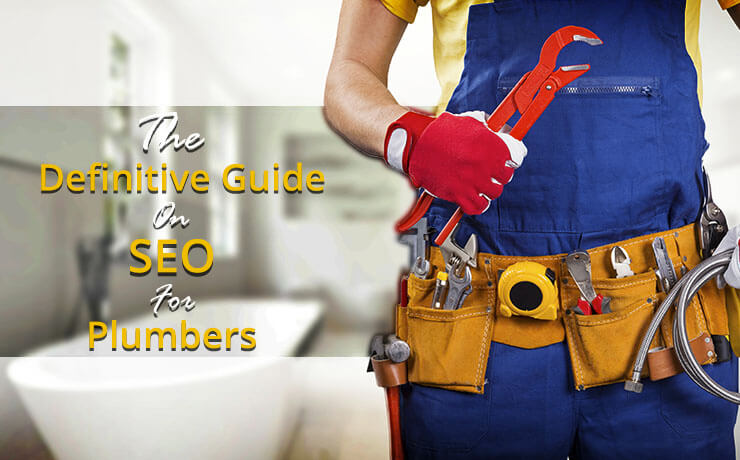The Definitive Guide On SEO For Plumbers

Clement Foo
Senior Digital Content Manager

In today’s world, a wide variety of companies utilize the Internet to promote their businesses, products, and services. Plumbers are increasingly turning to digital marketing to generate leads. This is the reasons why many business owners want their names to show up on the top when a potential lead looks for service providers like them. This is where SEO for plumbers comes into existence. When it comes to plumbing companies, there are countless of them in the United States. How can you differentiate yourself from others and become the first choice for your target audience? It is important to use the right plumbing SEO strategies to optimize your business locally and/or nationally. Without wasting any time, below is a definitive guide on how to perform SEO for plumbing companies.
Plan and Perform Plumber SEO Keyword Research
When it comes to plumbing SEO, business owners do not always hit the bullseye on the first try. Although some trial and error are to be expected, SEO is not something to make up as you go. Search Engine Optimization requires thorough planning via trusted analytical tools (e.g., Ahrefs, Google’s Webmaster Tools, and more) and keyword research. One of the main goals during SEO planning is to research and locate high opportunity keywords.
Before selecting any keyword, business owners should take note of the commercial intent. This famous keyword research term indicates if a user who performs the search query has plans to spend money. Queries such as “D.I.Y plumbing maintenance” do not have commercial intent and are not a good target for local plumbing businesses. You should aim to drive traffic that can be converted into sales. Some individuals may be looking for information only. That’s fine because they can provide some indirect value for your website. In this case, you will need to have resources that have the answers they seek. If their needs are not met and they exit your plumbing website quickly upon entrance, this affects your bounce rate and overall site ranking.
When you use a keyword research tool, remember that the main purposes are to generate keyword ideas and determine their monthly search volumes. Plumbing keywords with more monthly searches are typically harder to rank but can bring in more visitors. In most cases, the primary keyword that plumbers target will be along the lines of New Jersey plumbing services, New Jersey plumbers, or reliable plumbers in New Jersey. Long-tail keywords are essential for attracting visitors who are ready to purchase your services. After you have a list of intent keywords, start optimizing your website’s service pages and blog posts. Use them in titles, sub-headings, and the body content.
New Plumber Website Design and Development
Traditional websites typically have these basic pages: Home, About Us, Services, and Contact Us. Today, plumbers will need more than the aforementioned. It is recommended that business owners break down their website structure to include and capture more long-tail keywords.
- Plumbing Inspection
- Plumbing Maintenance
- Emergency Plumbing Services
- Sewer Line Cleaning Services
- Water / Heater Installation and Maintenance Services
- Toilet Repair
- Leaking Pipe Repair
- Pipe Reroute Services
- … and much more!
These keywords will become the titles of your subpages and it is important to include these terms in header tags, titles, and URLs. In other words, you should optimize each page of your plumbing website toward one primary key phrase or keyword. In addition to Contact Us and About Us pages, business owners should include secondary pages like FAQs, blogs, or any other pages that the customer base might be interested in viewing when visiting their plumbing websites.
The next step is to organize your internal link structure. Link your plumber website’s secondary pages internally from the main navigation menu that could be located at the top of every page. This practice helps funnel Link Juice (or Link Equity) from the homepage to these secondary pages. Another way to spread keyword relevance and link authority evenly throughout the site is to link each blog page to one or two other blog pages on the same website. Do not go overboard with internal links on a single page as search engines may view this as spam.
Technical SEO: Audit Your Existing Plumber Website
If you already have a website, there is still a lot of work to be done. For example, you should check your plumbing website’s health, as well as debug errors and identify areas for improvement. If you neglect problems, these issues can affect your position on the Search Engine Results Pages (SERPs). Here are some plumbing technical SEO components that require your attention:
- Crawl Errors: This issue occurs when search engines cannot reach a page of your website.
- XML Sitemap: This is a comprehensive list of page URLs from your site.
- Robot.txt File: This file instructs search engine crawlers not to crawl certain files.
- Toxic Links: These are unsecure and unnatural links pointing to the website.
- Page Load Speed: It is important to reduce page load speed to improve session timing.
- Duplicate Headers, Descriptions, and Titles: Avoid duplicating these elements as much as possible.
- Broken Links: Broken links could be the results of changing URL addresses without updating the URLs and/or adding incomplete URLs in the text.
Because Google has launched a mobile-first index, you should optimize your website so that it has a responsive design and is mobile-friendly. You can use Google’s Mobile-Friendly Testing page to determine if your site is offering mobile experiences that meet the search engine’s standards. These tests will point out which pages are not compatible with certain mobile devices.
In addition to having a mobile-friendly plumbing website design, business owners will need machine-friendly data as well. Also known as structured data or Schema markup, these elements help search engines understand various webpage content, such as events, reviews, addresses, and phone numbers. If your plumbing business serves several locations, create landing pages for every location. These pages should contain LocalBusiness Schema markup in the HTML segment to mark up content elements like the phone number, address, and business name. This is a great way to help webpages appear higher in Local Search results, especially for location-specific queries.
Implement Plumber On-Page SEO Best Practices
Optimize Image Alt Text
Plumbing images can be a quality signal for search engines. From primary web pages to blog posts, each page should include at least one image. After you have uploaded the required pictures, optimize the alt text. Also known as an alt tag, it is a brief description of what appears in the image. Make it a point to include the primary keyword in the alt text of at least one image per page.
Optimize Body Content
You will need to increase the word count of your web pages if they are under 400 words. Avoid adding filler content as you will need to accurately cover the topic you are conveying. For example, your homepage copy should mention the different types of plumbing services offered, city where your business is located, and have a call-to-action that encourages visitors to call or email you. Do not forget about your primary keyword. It should appear in the first paragraph and about two more times in the rest of the copy with slight variations.
Optimize H1 Headings
A H1 heading refers to the main title and states the overall topic of the page. Keep in mind that one page only requires one H1 heading. It is also a must to include the page’s primary key phrase or keyword.
Optimize Meta Descriptions
Meta descriptions are one of the most important elements of any web page. They provide a bit more information about the main focus of a certain webpage. Today, it is recommended that you keep the meta description between 130 and 160 characters (including spaces and symbols) to ensure it is displayed correctly in the Search Engine Results Pages. When it comes to writing meta descriptions, think of it as writing a very short summary of the content of the webpage. Other important elements to include are the main keyword and a call-to-action if possible.
Optimize Title Tags
Never underestimate the power of title tags as they are one of the strongest factors in search engine rankings. These tags should be less than 65 characters in length and include the primary target keyword or key phrase. This way, your title tags will not get cut off if they exceed the character limit.
Optimize Site URL Structure
It is best to keep your URLs short and keyword rich. Instead of using underscores, stick to dashes and lowercase letters.
Need Help with Plumber SEO?
To improve your plumbing SEO results, start planning out your website after performing quality keyword research and following the best practices of technical SEO, on-page SEO, website design, etc. Your efforts will pay off when you start receiving a steady stream of organic traffic. If you are new to SEO for plumbing companies, consider working with SEO specialists who are experienced in your industry.
 Free
Consultation
Free
Consultation Free
Google Ads Audit
Free
Google Ads Audit







